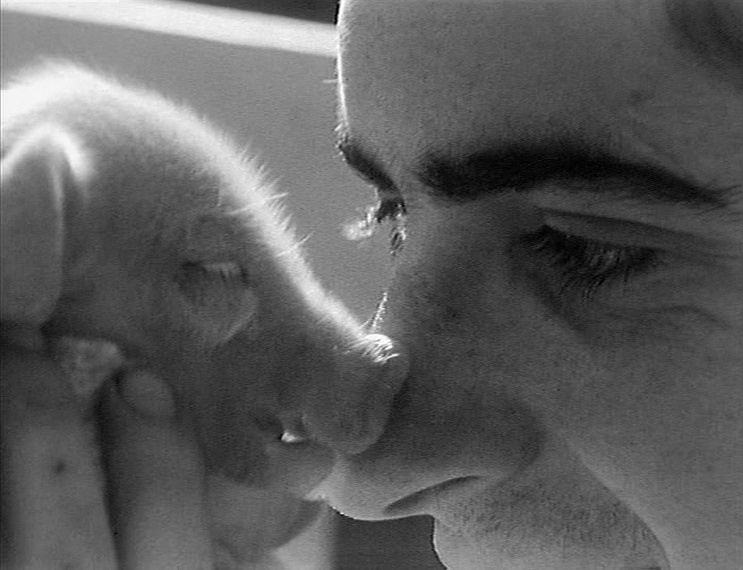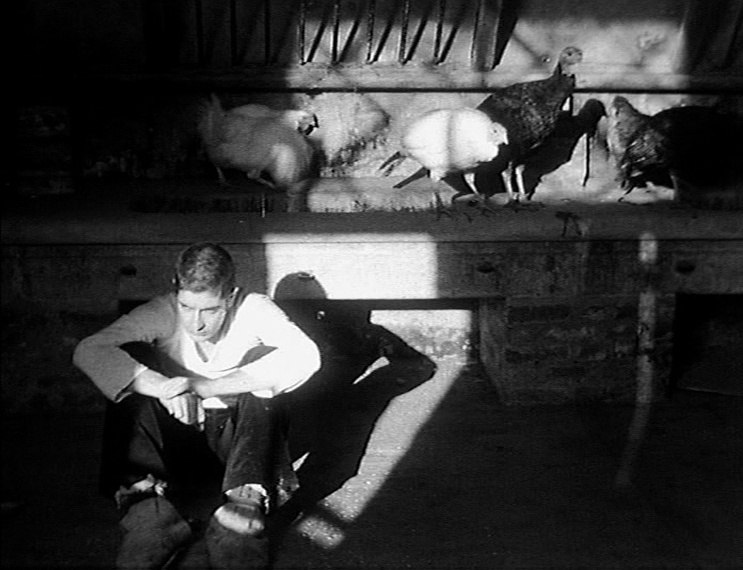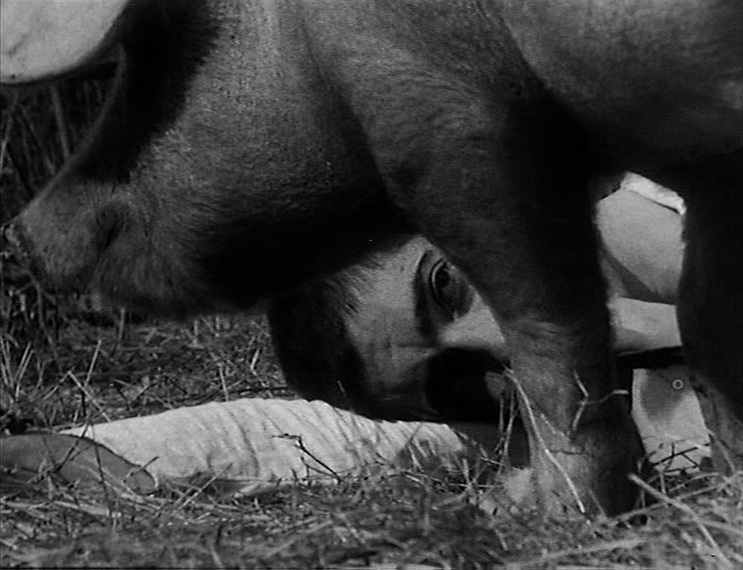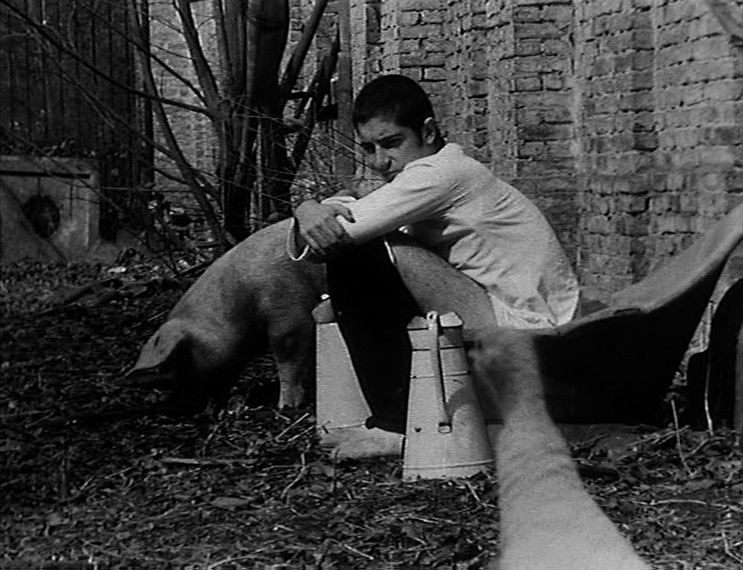
Jedan od onih krajnje kontroverznih/zabranjivanih filmova. Zašto, u ovom slučaju? Autist-čudak ševi prasicu, ima s njom "djecu" koju uskoro ubija itd.
www.zenofilms.be/
(aka "One Man and His Pig" or "Wedding Trough" or "Der Hochzeitstrog")
Although called A MAN AND HIS PIG in the US (and known in cult circles under a more reductive title which appears as a subtitle on the disc's cover), the official English title is THE WEDDING TROUGH. The French title's meaning is more open with VASE meaning vase or container as well as mud (in addition to being an antiquated euphemism for both the front and rear orifices open to sexual penetration) and NOCES or "wedding" is both a masculine and feminine noun. VASE DE NOCES is not a silent film but it features absolutely no dialogue because there is only one human character in the entire film (co-scenarist Dominique Garny) who lives amongst swine and fowl and collects soil and plant specimens (in the documentary, Zéno identifies him as an autistic). He eventually does mate with the sow and she conceives three piglets which he tries to raise as children. When he fails to connect with the the piglets (a seemingly benign scene in which he becomes frustrated trying to get the piglets to each from separate plates has the unnerving potential to erupt into an incident of domestic violence), he kills them (stillborn piglets were used) and the sow kills itself apparently out of grief. Left alone, the protagonist self-destructs amidst coprophagia and vomiting (put in context by Zéno in the documentary as both a regression as well as a sort of alchemic search for immortality). The bulk of the scenario culminates about an hour into the film and is followed by twenty minutes of extreme Pasolini-esque posturing including the aforementioned pre-SALO coprophagia, burying himself in the dirt, and wandering naked through a plowed field that resembles a barren landscape (both Zéno and Garny cite Pasolini and the direct influence of TEOREMA as opposed to PORCILE which was released the same year as this film but had not been viewed before production; Zéno also contrasts that film's use of pigs as a political symbol versus his use of the sow as a symbol of femininity). Resolutely arthouse, the film isn't quite as outrageous as its cult reputation suggests - only the easily offended might raise a stink - but it will appeal to more adventurous viewers. - www.dvdbeaver.com/
Plot: A farmer – who may or may not be the last man on Earth – lives on a farm in Belgium and falls in love with a big sow. After bonding with her in some very strange ways, he decides to consummate the relationship. Consequently, the very unlucky pig gives birth to a litter of human/pig baby/piglet-hybrids. He attempts to feed them all, but they only seem to want their mother’s attention. The [most stereotypical] farmer [in the world] becomes jealous and feels unwanted, so he kills all of the “hybrids”. When the sow hears of this, she commits suicide by drowning in a small pool of mud. The farmer-overcome with sadness (or because of the fact he JUST SCREWED A PIG), buries her, and even tries to bury himself along-side her. When this fails, he becomes furious, wrecks his house, and commits suicide via hanging.
Weird Moments: The farmer drinks tea made out of his own excrement; He fastens the heads of dolls to the heads of pigeons; He beheads a chicken for no good reason; The “couple” roll in the mud together, in order to bond; He collects strange materials in jars (which he destroys at the end of the movie).- listverse.com/

Bradford Film Festival 2006
Screentalk 16/3/06, Cubby Broccoli Cinema, National Media Museum
Interview with Thierry Zéno
Mark Goodall: How did you begin making films: what were your influences?
Thierry Zeno: Before I answer his I want to say thank you for inviting me and to say thank you to the Bradford Film Festival.
As a teenager I had a keen interest in making films with an anthropological, you could say psychological perspective. My work is also linked to literature, painting and the arts in general. Cinema allows you do things in two ways: deal with the man-made world and the creative world at the same time. You will notice that I have a particular interest in animals, especially insects. I sometimes wonder if I should have specialised in the study of insects…
So although I have a strong interest I animals I think that film responds best to my creative impulse. I’m particularly interested in the arts with a modern perspective so literature, poetry and painting such as the work of Felicien Rops, Henri Michaux, Hieronymus Bosch etc. Rops was a painter of the 19th century whereas Bosch and Bruegel were painters of the Renaissance. I’m also particularly drawn to the world of abstract art and its various forms.
When I say I was interested I films I was particularly interested not in commercial film but more experimental cinema. I was inspired by the US underground and what was coming out of the industry there, particularly in the late 1960s. Actually, when I was a film student I was quite a bad student because all of the traditional cinematic subjects such as theatre and set design really didn’t interest me at all. But then I turned my hand to making a film that was a personal subject of interest, a documentary set in a mental asylum. At that time I also became interested in the work of Jean Dubuffet, Art Brut and art which was outside the usual forms. Then I had the opportunity to speak to the director of a mental hospital who introduced me to a person who had been in the asylum for twenty-four years and who spoke to me of his experiences. This meeting was very significant; it represented one of life’s coincidences because this was a person I was almost ‘destined’ to meet and who was ‘destined’ to meet me. He’d been diagnosed a schizophrenic and had not spoken for twenty-four years and it was when he met me that he began to speak and to explain his feelings. This made me realise the depths of the unconscious mind and the way in which society can profoundly affect our minds.
I believe that Vase de Noces still carries something of that first meeting. Subsequently my readings and studies have focussed on the area of psychology and the works of Jung in particular. But poetry and painting have also fed into this film. It’s certainly true that in Vase de Noces there are scenes where all of this comes together and sequences which are very much related to the imagery of Bosch. There are other sequences in the film that are based on Jung’s principles of alchemy. Then I began to wonder how I could make a film that would combine my interests and at the same time would contain a storyline – a beginning and an end– and be an experience for the viewer, not just an intellectual process. You can see that there are a set of sequences with the actor Dominic Garny that are very carefully structured, where the scenario is extremely precise. We must also consider two very important factors. First: place, because for me place is actually a form of character within a film. The second thing is money! So the film takes place in Walloon in a castle in the south of Belgium. At that time I knew an American cineaste who was in some way taking advantage of the situation and using my phone a lot. One of things he did in exchange was to send me some 16mm film- a long distance connection with my film! Apparently this film was stolen form the American military where it was used to film bombers as they were dropping bombs. These were fifty feet canisters of film. They did not have the usual serial numbers on them, for when it is copied and from which the negatives are to be made. When I developed the negatives I then wrote my name in China ink on the footage, noting the frames by hand. We then threw away the working copy. That was the second occasion of madness in the making of this film! The first was the actual scriptwriting itself. The script was done in two parts: there was a series of sequences and then some improvised work as we went along. Depending on the weather or how the animals were behaving at the time we might have to redo a certain section of the film. It took us one month to make this film and the three of us involved: myself, the actor and the sound engineer were really separated from the world. We had to look after all of the logistical issues ourselves, for example make sure that the animals were fed. It was a life experience as well as a working experience.
MG: From the beginning the ‘use’ of animals in the film is very strong/abusive. Were you aware it would cause controversy?
TZ: Obviously the sow dies during the filmmaking but we did not kill the animal ourselves. This was done by the local farmer.
MG: How did you think of the idea for Vase de Noce; is the film based on religious ideas, is ritual a theme?
TZ: The principle idea behind all of the sequences in Vase de Noces is death. The film is about an alchemist who is attempting to find the secret of immortality. In the film he is not trying to change material into gold but trying to change death into life. This is why he is more preoccupied with the ‘signs’ of his death that he wishes to transform into ‘signs’ of life. When he is shown playing with his shit it is not simply provocative; it represents the idea of the metaphysical.
MG: What are your recollections of the reaction to the film?
TZ: I imagine what disturbed the audience was the fact that those images emerged from what is the unconscious mind- something that can emerge from our nightmares of the past, of childhood. Another thing that disturbed people was not the sexual intercourse with an animal but the preoccupations with his own body.
MG: How did you make the transformation from Vase de Noces to Des Morts?
TZ: All of these ideas about death at the metaphysical level of Vase de Noces I wanted to continue in documentary form, changing the style. The motivation to make Des Morts was not to wallow in the gloomy side of death but rather to explore a subject not discussed in daily life.
It seems that other, more ‘traditional’ societies maintain the presence of death in their daily life. To be clearer about this idea we decided to talk about our society and how traditional societies understood death more than our materialist society- a society that has lost the value of human life. We are arguing in the film that in countries where death is missing, human values are also missing. So we were motivated by a political aspect. But when we started the filming we were faced with the brutality of death and the intellectual ideas that we had at the beginning just faded away. It seems odd the say that there are good and bad systems of dying but it was a challenge to reflect this. It is clear that the silence about death is really negative. We found that in the USA, for example, all of facts surrounding death were about beauty and the hope of eternal life, the solitude surrounding people. It’s true that we found this way of behaving sad but it is also our (the producers) way of behaving. We continued with this approach and after several months of filming we wanted to show the different ideas that human beings have about death. It was a way of allowing the audience to see itself, the screen became a mirror for the audience to see their own life. That is the reason that most of the sequences that are rejected by the viewer occur when we show them what could happen to them. I think that this documentary was showing more than what could normally be shown but I am quite opposed to gratuitous films about violence- mondo, horror films etc. A documentary about death is obviously violent, death itself is violent. I wanted to show these extremes but for some people we went too far. For other’s it’s OK. I apologise to people who think that we went too far because the aim was not to shock.
MG: You said that it was easier to film these extreme scenes than to watch them. Could you comment on that?
TZ: Yes, for example in the autopsy and operation scenes, you are more preoccupied with technical matters surrounding the filming. There is more impact when you see it on the big screen later! I have to say that it was very difficult part of filming as we had to be there present at some difficult scenes. All of the families allowed us to be there, and being there meant that we had to share the same sorrow.
The filming took almost two years so there were gaps between those emotions. This is not the same when you are confronted with everything all at once in a ninety-minute film.
MG: I notice that in the version we screened some of the scenes had been removed. You filmed everything apart from one scene which you have since taken out (an execution in the Philippines). Could you explain this?
TZ: We cut nine minutes from the film- equivalent to two sequences- the execution and some scenes of ritual sacrifice of animals. We initially decided to leave the execution in the film because we wanted to talk about the death penalty. In France at that time there was a debate on capital punishment and we though it was very appropriate to show the real significance of the ‘death penalty’. As the debate ended it seemed that the sequence would be now out of place in the movie. In terms of the ritual sacrifice of animals, we wanted also to show the differences that exist between the killing of animals for the pleasure of humans compared to the sacrifice of animals in traditions of cultural importance. Later on we noticed that these sequences also did not have a place anymore.
MG: How did the film Ya Basta! come about?
TZ: After Des Morts I did not want to return to fiction anymore. This documentary changed me a lot and to make fiction seemed a waste of time. I also thought, rather egotistically, that making documentary would allow me to have a more intense life! I believed that my life would not have a sense if I was not working for people who do not have the opportunity to say what they want to say. So as a film producer I prefer to become an ‘interpreter’ for those who can’t say what they think. So I made a documentary in Chiapas (Mexico) where I met an Indian population that live in a very remote region, still marginalised by the oppression of the Spanish. I was very impressed by the desire of those people to keep their culture, their identity. They were not allowed to speak- their language was banned from schools and their history was hidden. They continue to be exploited economically. So I made a film about the history of the Tzotzil village which took seven years- not continuously- I went twice a year. To me this village was symbolic of things that were happening elsewhere so I continued to go there to get closer to these people.
I finished the filming in 1992 and it was shown on TV. I didn’t know that this experience was going to lead me to another film. But in 1994 the Indians of that region rebelled, led by subcommandant Marcos- the spokesman. I feared that these revolts would be bloody, as for example in Guatemala earlier. However, the rebellion gained a lot of support from other world leaders. The massacre I had feared did not happen. In 1996, two years after the revolt, nobody spoke about it, as if it was finished…





en.wikipedia.org/wiki/Vase_de_Noces
Nema komentara:
Objavi komentar